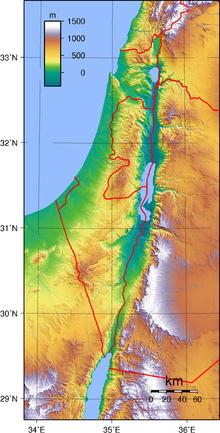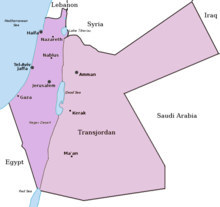Palestine (region)
Palestine, ancient Greek Παλαιστίνη Palaistínē, Arabic فلسطين, DMG Falasṭīn [falas'tˁiːn] or Filasṭīn [filas'tˁiːn], Heb: Biblical כְּנַעַן Kena'an, later אֶרֶץ יִשְׂרָאֵל Eretz Jisra'el (Land of Israel), rarely Cisjordan, is located on the southeastern coast of the Mediterranean Sea and usually refers to parts of the territories of the present-day states of Israel and Jordan, including the Gaza Strip and the West Bank. In various historical contexts, the region also bears other names such as the Land of Canaan or the Promised or Holy Land; in ancient Egyptian texts it is referred to as Retenu or Retinu, but also as Canaan. For Judaism, the Samaritans, Christianity and Islam the area has a special historical and religious significance. The names given are not to be regarded as synonyms; for example, the Torah refers to the land promised to the Archfathers of the Israelites as the land of Canaan, and the Kingdom of Israel and the city-states of the Philistines (Plesheth, from which the name Palestine is derived) were only some of the small states of the region in the 1st millennium BC - along with the Phoenician city-states, Judah, Ammon, Moab and Edom. In Arab tradition, Palestine is a part of الشام / aš-Šām, which encompasses the entire Levant and whose center is Damascus.

Topographic map of Palestine with internationally recognized state borders
Origin and use of the country name
Ancient
The name "Palestine" ultimately goes back to the Hebrew פְלֶשֶׁת peleschet, by which the area of the city-states of Gaza, Ashdod, Ashkelon, Ekron and Gath, founded or newly settled by a part of the so-called Sea Peoples (especially the Philistines), was designated. The inhabitants of this area are called in the biblical texts Hebrew פְלִשְתִּים pelischtim, German 'Philister'. Accordingly, in Assyrian written sources of the 8th century BC, the area of the present Gaza Strip as far as Ashkelon was also called 'Palastu'. Only in Greek texts, when the Philistines were no longer an ethnic entity distinguishable from the inhabitants of the hinterland, could this landscape name then refer to more than the southern coastal strip. The Greek historian Herodotus (fifth century BC) used the term "Syria palaistinē" to refer to the entire coastal strip between Phoenicia and the area of modern Gaza (Kadytis in Greek). The southern border of Phoinicia (the Levant i.e. mainly Lebanon), he probably drew at the Carmel Mountains. The Latin "Palaestina" goes back to the Greek name form "Palaistinē", attested since Herodotus.
In the Jewish-Greek translation of the Bible, the Septuagint (LXX), which was produced in Alexandria from the 3rd century BC, the term 'Palestine' does not appear. The LXX uses terms corresponding to the Hebrew original, such as the ancient Greek ἡ γῆ Χανάαν hē gē chanáan, German 'Land of Canaan', or the ancient Greek Ἰουδαία Ioudaía, German 'Judaea', to designate the whole land and its parts. When speaking specifically of Philistines, in the Pentateuch they were called ancient Greek Φυλιστιίμ Phylistiím, so the Hebrew word 'Pelishtim' (Philistines) was simply transcribed (e.g. Gen 10:14 LXX; Ex 15:14 LXX also for 'Peleschet'). In other books (e.g., the Books of Kings) the LXX regularly calls the Philistines 'other-stemmed' (ancient Greek ἀλλόφυλοι allóphyloi, e.g., 1 Sam 5:1 LXX;). Finally, Josephus in his Antiquitates Iudaicae (c. 100 AD) calls the Philistines (and only them) 'Palaestines' (ancient Greek Παλαιστῖνοι Palaistînoi, e.g. Ant 6:1).
Roman Empire
Emperor Augustus gave the former Philistine land to King Herod the Great; he in turn gave it to his sister Salome, who made it a Jewish coastal province. After the suppression of the third Jewish revolt (Bar Kochba Revolt 132-135), the Roman Emperor Hadrian renamed the Roman province formerly known as Judea Syria Palaestina, destroyed its capital Jerusalem, and rebuilt it as Aelia Capitolina. His wish was that Jerusalem and Judea would be forgotten forever. In late antiquity, some areas east of the Jordan River were also geographically included in the province of Palaestina, which was divided into three parts in the fourth century. Militarily, however, Palaestina remained a single entity.
Early Islamic Period
When, in the course of Islamic expansion, the region was incorporated into Muslim rule in 636, the new rulers divided the land into junds, which were military districts. The area, which formed the most important part of the Byzantine (Eastern Roman) province of Palestine Prima, was given the Arabic name "Jund Urdunn" "Military Province of Jordan" (after the river) and "Jund Dimashq" (Damascus). Thus, the name Palestine disappeared in the Eastern world until after the end of the First World War.
Crusader States
The Christian Crusaders established the Crusader states and formally called the region the Holy Land, but they also handed down the name Palestine, which has been in use in the Western world until modern times. The Kingdom of Jerusalem existed from 1099 to 1291. The German term "gelobtes Land" is a translation of Latin terra promissionis, "land of promise".
Mamluk period
The Mamluks finally defeated the Crusaders, first as the elite Ayyubid corps, then as rulers over the entire region after they took power themselves under Baibars. During this period, Palestine served them mainly as a transit area between their two main cities, Cairo and Damascus.
Ottoman Empire
From 1516 to 1918, Palestine was part of the Ottoman Empire. At the outbreak of World War I, the region was divided into three districts of the Ottoman Empire: The Wilajet Syria, the Wilajet Beirut, and (the larger part), an unnamed region around Jerusalem that was not legally assigned to any administrative district.
The 19th and 20th century
In the 19th century, historians in the West increasingly resorted to the term Palestine, but it only experienced a rebirth with Zionism at the end of the century. Zionists like Theodor Herzl understood their movement as secular and wanted to avoid religious connotations, although they certainly saw the religious motivation:
"Palestine is our unforgettable historical homeland."
- Theodor Herzl
Already at the first World Zionist Congress (August 29-31, 1897) in Basel, the goal was set:
"Zionism seeks the creation of a public-law homeland in Palestine for those Jews who cannot or will not assimilate elsewhere."
The designation was subsequently used in the 20th century for the British League of Nations mandate for Palestine, which in turn was divided into the smaller Cisjordan (neo-Latin for "land on this side of the Jordan River") from the Jordan westward to the Mediterranean and the larger Transjordan ("land beyond the Jordan") to the east. The latter was the official state name of Jordan until 1950. In French and English especially, Cisjordan refers to the whole area west of the Jordan River, and the use of the term Cisjordan for the West Bank alone, i.e. for the areas now largely controlled by Israel, is rather rare in these languages. In the German-speaking world, Cisjordan is rarely used to refer to the West Bank.
Today, the term Palestine usually covers the area between the Mediterranean Sea and the Jordan River - i.e. the territory of Israel as well as the Palestinian territories occupied by Israel since 1967 (West Bank including East Jerusalem and the Gaza Strip).

Borders of Cisjordan (medium violet) and Transjordan (light violet), c. 1922
Origin of the term Palestinian
→ Main article: Palestinian
The adjective Palestinian usually refers to ancient Palestine, for example the term "Palestinian Jews". The word Palestinian, on the other hand, did not come into use until the mid-1960s to refer to the present-day Arab population of East Jerusalem, Gaza, and the West Bank. Egypt's occupation of Gaza and Jordan's occupation of the West Bank after 1948 was followed by Israel's occupation of both lands in 1967 as a result of the Six-Day War. As a result of this and the related emergence of the PLO, Arab residents of both territories increasingly began to use Palestine and Palestinian to express their hopes for a distinct Palestinian nation (e.g., "Palestinian uprising"). The majority of Christian and Muslim Arabs who are citizens of Israel and live within its pre-1967 borders also refer to themselves as "Palestinians" today.
Questions and Answers
Q: What region is Palestine located in?
A: Palestine is located in the Middle East, in the Levant region between the Jordan River and the Mediterranean Sea.
Q: What civilizations have lived in Palestine throughout history?
A: Throughout history, many cultures have built their civilizations in Palestine, such as the Philistines, Phoenicians and Arabs.
Q: Why is it called the Holy Land?
A: It is called the Holy Land because it is where Judaism and Christianity began.
Q: How many states are there today in this region?
A: Today, this region is divided into two states - Israel and the State of Palestine.
Q: Which cities are sacred to Abrahamic religions?
A: Cities that are sacred to Abrahamic religions include Jerusalem, Bethlehem, Nazareth and Hebron.
Q: How much of the country does Palestine own today?
A: Today, Palestine only owns a quarter of its original country.
Q: Who were the Philistines?
A: The Philistines were a people who invaded this area; they were likely Romans who did not speak Arabic since Arabs arrived to Palestine nearly 2000 years later.
Search within the encyclopedia